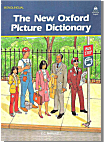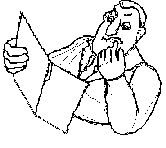

| Book of the Month | ||
 |
The New Oxford Picture Dictionary |  |
Publisher: Oxford American English
Author: E.C. Parnwell
$28.00
ISBN 0-19-434199-2
The English proverb says that 'A picture paints a thousand words'. This picture dictionary has not one picture but hundreds, although each picture shows only a dozen or so words. The idea behind this very successful book is simple. It shows a picture, or a set of pictures with numbers on each part of the picture it wants to describe. Below the picture is the vocabulary which goes with each number. So a picture of a man with a dog would have the man numbered '1' and the dog numbered '2'. At the bottom the vocabulary would show '1. man' and '2.dog'. This idea is done in two different ways. The first way shows a number of pictures, with one word for each picture. The second way is to have a single picture, and the things in vocabulary shown by numbers in the picture. So the picture on the cover, for example, actually shows types of clothing, with vocabulary underneath showing the names of things like the construction worker's helmet and the security guard's cap. The book reviewed here is the monolingual version, but the series offers books with vocabulary given in both English and one other language. There is a large range of these books including English/Russian, English/Spanish and English/Vietnamese.
There are 124 pages in the book, of which pages 2 to 103 are pictures and vocabulary. Pages 105 to 124 are the index, where you can look up any one of the 2,400 words and pictures shown in the text. The book tries to arrange the vocabulary in the order in which a beginner would want to learn them, so the first words are of family members (e.g. 'Uncle', 'Aunt', 'Grandfather') and the next exercise illustrates parts of the human body. From there we get pictures of food, and then the supermarket. Later the book illustrates verbs - so that 'kitchen verbs' on p.31 shows actions such as chopping, peeling and grating, and later baking, boiling and frying. So the student learns what to buy, where to buy it, and how to cook it in that order. Towards the end of the book 'Prepositions of Description' shows a roomful of cats, with cats 'on' the rug, 'at' the window, 'behind' the chair and so on. The pictures are colour drawings which usually take up four-fifths of each page with the vocabulary underneath that. It is usually very clear which word goes with which number in the picture, even when more difficult ideas such as prepositions of motion are introduced. Some parts of the book illustrate particularly American culture - such as the players in a game of American football. Sometimes the vocabulary choices seem odd for beginners - there must be many words a student needs to know before learning 'uranium rods' and 'transmission towers' for example. (British speakers know the latter as 'electricity pylons'.) Nevertheless the vast majority of the words here are relevant and useful.
Who is this book for? Despite the American orientation of the vocabulary, any beginner needing a wider vocabulary would benefit from this book. The book is both a useful guide to general vocabulary and good for preparing for specific situations. For example someone contemplating a journey might like to first look up the sections dealing with travel, and learn expressions such as 'carry-on bag' and 'boarding pass' for airports and 'conductor', 'track', and 'platform' for train trips. Apart from such specialized usages, the book will enrich a user's vocabulary, and teach things like the difference between a windbreaker, a sweater and a jacket. The book is relatively large, but is light enough to be carried in a backpack for quick reference during visits to places such as a doctor's clinic or the supermarket.
Verdict: See the picture, learn the word. Simple.
Assessment 10/10